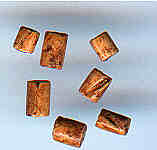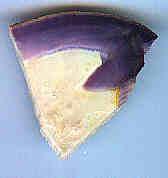Principal path =Home>Trade Beads > Wampum > Pictures
America's Most Important Shell Bead
Most everyone has heard of Wampum, but few people really know what it is.
Wampum is a small bead made from shell. The story of Wampum is a crucial chapter in American history. You can explore it here.
On this page we will discuss the shells behind Wampum. There were two types of these beads. The more common one was white. The move valuable (two to three times the value of the white) were violet in color, though they were also called black or blue.
White Wampum was made from a variety of shells, mostly univalves (whelks and conchs). It was common to make them from the columella, the central supporting column of these shells. (see here).
|
The dark wampum had only one source. The quahog clam, which lives along the Atlantic coast, has a patch of deep violet in its interior. That was the material for "black wampum. The quahog is a Venus clam, the most diverse mollusc family. When Linnĉus was developing his classification system he was well aware of the use of Wampum for money (among the European settler, not the Native Americans) and named this animal Mercenarius (Venus) mercenarius. "Mercenarius" come from the Latin, ultimately meaning money. Compare mercenary, merchant, mercantile, etc.
|
Last Gallery Page Next Gallery Page
__________________________________________________
Small Bead Businesses | Beading & Beadwork | Ancient Beads | Trade Beads
Beadmaking & Materials | Bead Uses | Researching Beads | Beads and People
Center for Bead Research | Book Store | Free Store | Bead Bazaar
Shopping Mall | The Bead Auction | Galleries | People | Events
The Bead Site Home | Chat Line | Contact Us | Site Search Engine | FAQ


